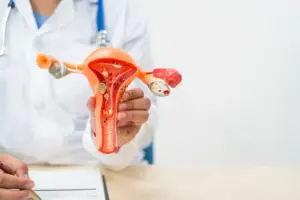Endometriosis is a chronic condition that affects many women and often remains undiagnosed for years. It arises due to a complex interplay of hormones, inflammation, and tissue reactions. Various phases can be identified, which reinforce each other and create a vicious cycle. However, there are targeted ways to break this cycle.
Phase 1: Stress → Increased Cortisol Levels
Chronic stress, whether due to persistent pain or psychological strain, leads to an increased release of the stress hormone cortisol. The problem: Cortisol inhibits progesterone, leading to estrogen dominance. This hormonal imbalance promotes the growth of endometriosis.
Phase 2: Estrogen Dominance → Accelerated Endometriosis Growth
Estrogen promotes the growth of endometriotic lesions, which in turn trigger inflammation. Studies have shown that aromatase activity is increased in endometriosis tissue, enhancing the conversion of androgens into estrogens. Since progesterone becomes resistant to these processes, it can no longer sufficiently inhibit growth.
Phase 3: Chronic Inflammation → Immune System Dysfunction
Endometriotic lesions release pro-inflammatory cytokines that activate the immune system. However, instead of eliminating the lesions, the immune system reacts incorrectly, further intensifying inflammation. This can lead to leaky gut and systemic autoimmune reactions.
Phase 4: Gut Issues → Impaired Estrogen Detoxification
An imbalanced gut microbiome can result in inadequate estrogen elimination. Contributing factors include:
- Dysbiosis: Fewer beneficial gut bacteria promote the reabsorption of estrogen.
- Leaky Gut: Inflammation increases the permeability of the intestinal wall.
- Liver Overload: Impaired detoxification function raises estrogen levels, further stimulating endometriosis growth.
Phase 5: Increased Pain Sensitivity → Nervous System Overstimulation
Chronic pain can lead to central sensitization of the nervous system. As a result, pain stimuli are perceived more intensely, even if they are mild. Persistent pain increases stress – and the vicious cycle starts again.
Phase 6: Exhaustion, Hormonal Imbalance & Secondary Conditions
Due to continuous strain, additional issues arise:
- Nutrient Deficiencies (e.g., magnesium, omega-3, B vitamins)
- Thyroid Problems (e.g., Hashimoto’s disease)
- Exhaustion, Burnout & Depression
FSM Therapy: A Targeted Way Out of the Cycle
An effective method to break this cycle is Frequency-Specific Microcurrent Therapy (FSM). This innovative therapy uses microcurrent frequencies to specifically target adhesions, inflammation, and pain.
The Benefits of FSM for Endometriosis
✅ Gently dissolve adhesions: FSM can release deep-seated adhesions and improve organ mobility.
✅ Reduce inflammation: Specific frequencies help regulate inflammatory processes and calm the tissue.
✅ Relieve pain: FSM influences neural pathways and supports natural pain processing.
✅ Promote tissue regeneration: FSM can help soften hardened tissue and minimize discomfort.
FSM in Practice
- Gentle Treatment: Electrodes are placed on the abdomen and back to direct microcurrents through the affected tissue.
- Individualized Therapy: Each session lasts 60-90 minutes, with 1-2 sessions per week recommended over 4-6 weeks.
- Complementary or Standalone: FSM can be used post-surgery or as a non-invasive alternative.
Endometriosis Treatment at ELEVA RESTORE in Zurich
At ELEVA RESTORE in Zurich, Frequency-Specific Microcurrent Therapy (FSM) is specifically used to alleviate endometriosis symptoms. Many patients report improved mobility, reduced pain, and an enhanced quality of life after treatment.
By combining modern technology with years of expertise, FSM can help dissolve adhesions, reduce inflammation, and support the natural function of affected tissues. The therapy is individually tailored to achieve the best possible results.
Endometriosis can be a significant burden, but there are effective methods to relieve symptoms. For more information on FSM therapy and personalized treatment options, visit:
https://eleva-restore.com/de/services/behandlung-von-endometriose/






